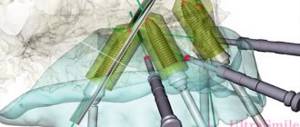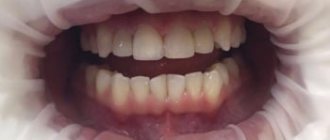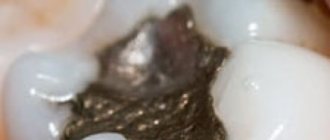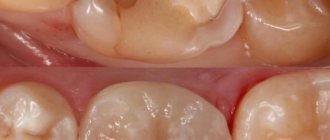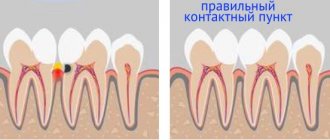Light fillings harden only under the rays of a curing lamp, as a result, the dentist is able to fit them into the desired shape with exceptional precision.
They are stronger than ordinary cements, last longer, and are also easy to select in shade and invisible to prying eyes. Light-curing filling is also called light-curing, helio-curing, light-curing or photopolymer.
Advantages and disadvantages
Compared to chemical fillings, light-curing fillings have some advantages:
- Polymer materials combine increased strength with an aesthetic appearance. It is not difficult for the dentist to select the required color of the filling and make it invisible.
- Composites are easy and convenient to work with. All components are packaged in portions in capsules and syringes, which reduces the preparation time of the composition. The specialist does not need to fear that the solution will harden at the most inopportune time, so he can work more painstakingly to create the required shape.
- Through grinding and polishing, a natural, similar to natural, tooth shine is achieved.
- Light composites are not susceptible to oral microflora
- Using an elastic polymer material, it is easier for a doctor to accurately recreate the shape of a dental crown.
- Treatment does not take much time and is carried out, in most cases, in one visit.
- The material is securely held inside the cavity. Heliocomposite penetrates and seals even the smallest cracks.
- During operation, polymer compositions do not shrink.
- The inside of teeth can be filled without drilling. The liquid composition does not require precise adjustment of the shape and size of the cavity.
- The light filling serves as reliable protection and prevents further tooth decay.
- The material is non -toxic, does not cause allergic reactions and is completely safe for health.
Let's find out why a tooth hurts after a temporary filling
Speaking about the advantages, one cannot fail to mention the disadvantages, including:
- the likelihood of excessive shrinkage of the light polymer during the hardening process and the danger of its detachment;
- change in the shade of the filling in cases of incomplete light polymerization of the material;
- it is inappropriate to use a reflective composition for the treatment of large carious cavities due to the difficult prediction of shrinkage volumes and the significant increase in cost of filling.
Dentists try not to use photopolymer composites in hard-to-reach areas. In this case, ultraviolet treatment may not be sufficient and the filling will not harden completely.
Composite compounds
Chemically cured composites were invented as an alternative to simple cement fillings. The composition of the composite includes porcelain, which gives greater strength to the cement. Also, according to their composition, composites are divided into three types:
- acrylic-containing;
- resin (epoxy);
- light-curing.
Of the listed compositions, the acrylic-containing composite has the greatest strength. These fillings are characterized by wear resistance, are little susceptible to abrasion, however, they have a toxic effect on the body. Due to toxicity, acrylic is contraindicated in many patients. Acrylic also often provokes the formation of pulpitis. Another negative feature of acrylic is its high absorbency, due to which the risk of caries increases significantly.
Resin composite material is not highly wear-resistant and durable, however, it is non-toxic and harmless to the body. The disadvantages of resin structures include a change in color after a few years: the fillings darken. Another feature of resin (epoxy) fillings is their excessive fragility: they can break off and be “eaten.” Therefore, it is better not to use epoxy composition on primary chewing molars. Epoxy composite also provokes the development of pulpitis, just like acrylic.
The light-curing composite gains its strength from a halogen lamp. They are also called photopolymer or solar-cured. The disadvantage of this material is the complexity of installation: polishing and grinding of the material is necessary. The filling must be polished every six months to maintain the original tone of the material.
What other disadvantages are typical for this material? These include the following properties of the filling:
- shrinkage after curing;
- possible chipping of the crown wall;
- poor-quality hardening of the material.
The filling can shrink up to five percent of its original volume, which significantly reduces the effectiveness of protecting the tooth. Even with slight shrinkage of the filling, there is a high probability of chipping of the adjacent wall of the dental crown. Due to the technical difficulties of working with a halogen lamp, the hardening of the material may be incomplete - only 70%.
An innovation in modern dentistry is a nanocomposite, the structure of which consists of tiny particles. The nanocomposite is characterized by high adhesion to tooth tissues, providing reliable protection against infection and the spread of caries.
Components of a light seal
The components of photopolymers are substances that harden under ultraviolet rays.
The light composite consists of environmentally friendly ingredients and is therefore absolutely safe for humans. Filling material is made from:
- A polymer matrix representing blue light waves with a length of 450 nm. It is this component that allows the solution to harden from ultraviolet exposure.
- A special filler consisting of a mixture of silicon dioxide particles, boryl glass, glass ceramics and other elements.
- Binder .
The bulk of fillers for reflective polymers are produced in Japan, Germany and America.
There are micro-, mini- or macrofillers of the filling solution, and the main component can be a nanohybrid composite. The ultraviolet-sensitive ingredient polymerizes when exposed to light and reliably protects sensitive parts of the tooth.
The use of macrofillers, the largest inorganic particles, is used to restore the chewing surface of the lateral teeth.
Find out why a tooth hurts after filling
This area is not visible during communication, so small deviations in color and texture are not noticeable. Fillings have the greatest strength, they are radiopaque and the shade is close to the color of the teeth. Along with the advantages, macrofillers have some disadvantages:
- are difficult to polish and do not have a “dry shine”, i.e. differ from natural enamel;
- have a rough surface after drying;
- have poor color fastness;
- inhibit dental plaque more strongly
Microfilled composites are less resistant to mechanical stress, but due to their advantages they are used more often. Such lighting composites:
- easy to polish;
- have a stable glossy surface;
- have color fastness;
- superior to macrofillers in aesthetic characteristics;
- multifunctional, suitable both for eliminating the consequences of caries and as a restoration material.
Microfilled compositions have sufficient aesthetic characteristics, but are inferior in strength, are less polarized and are suitable only for small cavities. Therefore they are not widely used.
The nanohybrid composite is considered the most advanced. It consists of ultra-fine particles and combines the positive properties of all of the above materials in an improved form. The filler is used to perform dental procedures of any complexity.
Features of the composition of a light-curing filling
Photopolymer materials (composites) used in the manufacture of fillings consist of two main components: a bulk filler and a light-curing polymer. These materials can be varied, their use depends on a number of factors: the location of the filling on the tooth, the intended purpose of the filling and the aesthetic preferences of the patient.
Types of fillers for light-curing fillings:
- Macrofillers are the main component of most popular photopolymer fillings. They have high strength and good radiopacity, allowing the doctor to evaluate the quality of work after the procedure (which is especially important in the process of filling canals). They have a fairly rough, rough structure and are subject to slight pigmentation, therefore they are used for filling chewing molars and other non-facade teeth;
- Microfillers – have a finely dispersed structure that increases the overall aesthetic appeal of the filling material. This filler has a uniform, stable color, practically does not undergo pigmentation and acquires a specific shine to tooth enamel after polishing. Used for filling anterior teeth where aesthetics play a critical role;
- Minifillers are a universal solution that combines the properties of macro and microfillers. Due to the lack of pronounced advantages, they are used quite rarely, as a rule, for filling small defects. The key disadvantage of fillings with mini-fillers is the difficulty of processing and polishing, with average resistance to mechanical loads.
- Nanohybrid fillers are the most modern and expensive material. It has a whole range of advantages over traditional solutions and has good plasticity, increasing the comfort of use in hard-to-reach places in the oral cavity. It also does not stick to the instrument and is used for the restoration of teeth with varying degrees of damage;
The choice of material for installing a light-curing filling is made by the doctor, based on the data of the initial examination, the characteristics of the tooth being filled, the size and complexity of the carious cavity, as well as the individual preferences of the patient.
Classification of light seals
The division of light-polymer fillings into types occurs in accordance with the location of their installation.
For front teeth, a high-quality composite is required, which should not only perform a protective function, but completely match the color and texture of the enamel. When treating chewing molars, you can sacrifice aesthetics in favor of strength.
Photopolymer compounds are often used as a restoration material to remove scratches and chips. Despite the fact that the service life of a restored tooth is only 5 years and it requires more careful treatment, the procedure is in demand due to the speed of execution. The whole process only takes a couple of hours.
Which material to prefer
The dental compositions described above have their own characteristics, advantages and disadvantages. Which filling do you prefer? Which is better - light or chemical (ordinary)? The choice will depend on financial capabilities and the location of the tooth in the oral cavity - posterior molar or frontal.
It is preferable to place fillings made of durable, indelible compositions on posterior chewing molars. For example, metal, glass ionomer or nanocomposite materials.
If we consider from an aesthetic point of view, it is better to put light or ceramic fillings on the front teeth, which are identical to tooth enamel and are invisible when smiling. Light dental products are characterized by a certain fragility, and therefore cannot withstand heavy chewing load on the rear molars.
To restore a chipped or damaged tooth in the front rows, light fillings are used. Using a composite material, you can completely restore the shape of a tooth, which will look organic. A distinctive feature of the light composite is the versatility of choosing a color to match the tone of the natural enamel of the teeth.
If we consider the quality of the composition from the standpoint of durability, then the most durable materials are metal and photocomposite - a service life of more than ten years. All other trains last from four to five years.
Sources used:
- Klyomin V. A., Borisenko A. V., Ishchenko P. V. Combined dental fillings. MIA, 2008
- Practical therapeutic dentistry" (Nikolaev A.)
- Scheller-Sheridan C (8 May 2013). Basic Guide to Dental Materials. John Wiley & Sons.
- https://www.dentalhealth.ie/
Indications for installation
Light-curing fillings are recommended by doctors in a number of cases:
- In the presence of carious destruction, even if the affected area makes up more than 50% of the tooth, a change in the color or size of the crown.
- To restore damaged and chipped teeth. Restoration is carried out only if the surviving fragment is more than half of the original.
- The use of a composite as a retaining element in identifying pathological tooth mobility of 1 or 3 degrees.
- For minor damage to the enamel, small chips or scratches. Other materials are not able to adhere to such areas.
- In the treatment of pathological processes in the root zone or cervical area of the tooth.
- For masking various pigment manifestations.
Reflective materials are truly versatile and suitable for a variety of dental applications.
In what cases is it used?
Indications:
- carious and non-carious destruction;
- pathological changes in the size and color of crowns;
- injuries requiring restoration of chips, correction of damaged teeth (only if the coronal part is preserved at least 50%);
- pathological mobility I-III degrees (have a holding effect);
- small enamel defects (light-curing compounds allow you to create patches in small areas where other compounds will not adhere).
Installation technology
Treatment using light-curing solutions differs from other methods and consists of several stages:
- Examination of the oral cavity by a dentist, identifying the problem and applying local anesthesia.
- Removal of areas affected by caries, thorough cleaning of destroyed tissue.
- Treatment of canals with special antiseptic agents to prevent infectious lesions and re-development of caries.
- Filling the dental cavity for 7 days with temporary cement in patients with pulpal caries.
- Selection of the required shade of the material using a special scale. It is very important to correctly determine the tone of the filling material and maintain it throughout its entire service life. The composite cannot be bleached, so it will be impossible to restore this indicator with any treatment.
- Preparation of the oral cavity for treatment, which consists of isolating the treated area with cotton swabs or a latex plate, installing a saliva ejector.
- Application of a special composition on the inside of the tooth walls to soften the dentin. The treatment promotes better adhesion between the tooth and the composite. The product is washed off with water after 40 seconds, and the surface to be treated is thoroughly dried.
- Distribution of an abrasive substance over the surface of the prepared cavity. This measure guarantees reliable fixation of the seal.
- Installation of a special plate when treating minor lesions or in more complex cases using a pin as a frame.
- Gradual application of filling material. To obtain the required volume, the composition is applied and dried with ultraviolet light in layers. To polymerize the solution, several seconds of photoexposure are required. LED lamps are equipped with special sensors and turn off automatically after the required time. Exceeding this period is undesirable, since overdrying of the composite can cause the formation of cracks and damage to tooth enamel.
- Grinding is carried out after the carious area has been completely closed and the tooth has been given the desired shape. So that there is no discomfort when the upper and lower rows of teeth come into contact and the patient does not have the feeling of the presence of a foreign object in the mouth.
- polishing . It is important to give an aesthetic appearance, especially if the front teeth are being treated.
- Additional coating of the tooth with dental varnish. The resulting layer provides tooth enamel protection and increases the wear resistance of the filling.
Depending on the degree of carious destruction, the process takes from 30 minutes to an hour, and the use of anesthesia makes the procedure painless for the patient.
After installing the filling, there is no need to wait until you eat. You can eat and drink immediately, but dentists still recommend refraining from eating for 40 minutes after completing the procedure. To increase strength, it is better to increase this period to 2 hours.
Also, to preserve the quality and shade of the light polymer for a long time, experts advise following simple rules in the first week:
- Refrain from eating coloring foods: berries, black tea, coffee, red wine, beets, etc.
- Minimize the amount of sweet foods you eat.
- Strengthen the overall health of your teeth by adding more dairy products, fresh fruits and vegetables to your diet.
Avoiding solid foods will help preserve the integrity of the filling, protect it from chipping and reduce the risk of failure.
Conventional chemical
The main difference between a simple (chemical) filling and a light filling is how they harden. A regular filling becomes hard due to a chemical reaction that occurs when different types of filling material are mixed. The result is a consistency with the required density and elasticity.
Dentists typically use two types of conventional chemical fillings:
- Composite - it contains several different chemical ingredients, which, when hardened, can differ significantly from the natural color of tooth enamel. The material hardens evenly, but does not last long - usually about 2 years.
- Glass ionomer - contains a special liquid and powder, which are mixed in the required proportion.
The composition hardens due to an acid reaction. Dentists can add additional components to this mixture as needed. Attention! Glass ionomer filling is good because it has the ability to release fluoride, which serves as a preventive measure against the re-development of caries.
Life time
How long a light seal will last depends on:
- composition of the selected composite;
- quality of specialist’s work;
- oral care rules
If all three conditions are met, the warranty period is at least 5 years. In reality, the filling lasts much longer. To monitor the condition of your teeth, you need to regularly visit the dentist and undergo an examination. If small flaws are detected, the doctor can restore the surface and give it its original appearance.
Quitting smoking, reducing the consumption of strong black tea and coffee, and brushing your teeth daily in the morning and evening will help preserve the color of your filling for a long time.
The use of photopolymer materials has brought dentistry to a new level. Unfortunately, the cost of light-curing composites remains high and not everyone can afford this method of treatment. But it is worth noting that their price fully corresponds to the quality and does not make patients regret the money spent.
The procedure for attaching to a state clinic and the list of required documents
- Call the indicated clinics to find out the relevance of the information and the list of services that are actually provided free of charge.
- Go to the public dental clinic to which the policy is attached and ask at its reception for a referral to a private clinic where the patient is going to have his teeth treated.
- Contact a commercial institution, sign up for an examination and undergo treatment.
List of free dental services under the compulsory medical insurance policy in 2021
Photopolymer light fillings are practically not installed under compulsory medical insurance policies, which is due to their high cost and insufficient funding from insurance funds. In a public clinic, you can get such a filling only for medical reasons. Typically, dentists install them on the front teeth or in cases of cervical caries.
If the dentist's office is located in the building of a regular clinic, no additional attachment is required. If the dental clinic is a separate institution, then attachment to it is necessary.
Caring for the filling after installation
After the procedure for installing a light filling, the patient should understand that this type requires more attention in the first stages after installation.
By determining for himself how to care for the light filling, the patient will help extend its service life and improve its aesthetic and healing properties. To do this, you need to follow your doctor's recommendations and avoid contraindications.
You should strictly monitor your diet. What is better to neglect in nutrition? These are tea, coffee, carbonated drinks (Coca-Cola), pomegranate and blueberry juice, borscht. These products can stain the filling, making it a different shade from the rest of the tooth. It is also recommended not to consume flour products and sweets during the first three days after the filling is installed. But eating grains, vegetables and fruits, on the contrary, is useful for strengthening teeth, which also contributes to the long service life of the filling.
Care
The rules for caring for photopolymer fillings are practically no different from ordinary oral hygiene.
Patients simply need to brush their teeth regularly with a soft toothbrush and rinse their mouth with warm water or a special solution after each meal.
It is also important to regularly, at least once every six months, have a routine examination with a dentist. Only if problems are detected in a timely manner can they be easily eliminated and the development of more serious diseases prevented, and accordingly preserve the integrity of the tooth that has been restored.




